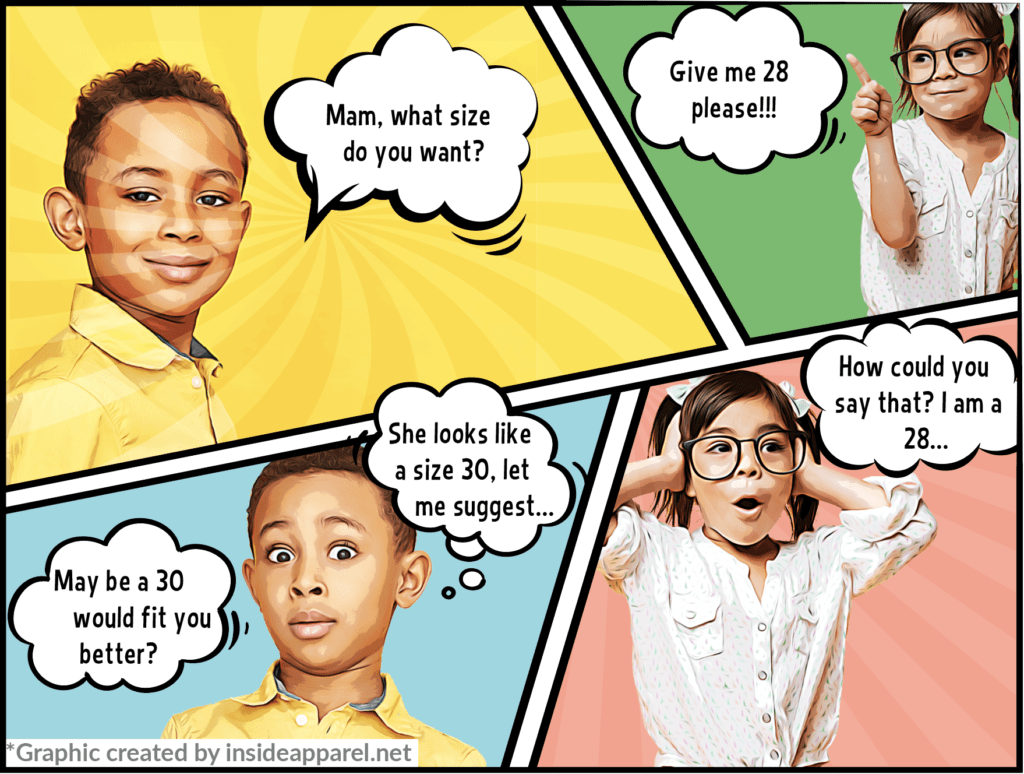Anecdote # 7
What size do you wear?
More often than not, the answer to that question is “hesitation”.
Yes, you read that right. Hesitation it is!
In a world where body-shaming is still a reality, opening up about the size of your clothes or your preferred fits is a very difficult thing to do. Particularly when you walk into a store and have to ask the salesperson for your size.
This is not just because of how the outside world judges you, but also a matter of self-perception.
Of course, these things don’t matter if you have spent hours working out and have a body you can flaunt – and these people are rare.
What does that have to do with fashion retail, you say?
Well! Actually a lot, particularly if you are selling in a store.
My last blog rejigged my memory and reminded me of many incidents from my first job. Some from my days spent on the retail floor, which gave me insights into the consumers’ minds.
For those who came in late. As management trainees, we were sent to the store for some months to sell and ended up managing the whole counter ourselves. Click to read the previous blog.
So there I was, first job, trying my best to manage my sales targets.
And these were the days when no one taught you much.
We just learnt on the job. And the consumers taught me a lesson I cherish till date.
One of those days, in walked a customer and

Not to offend her further, I quietly gave her the piece in a size 28 to try.
And a few minutes later with irritation written large over her face, she said ‘your fit is bad, I don’t like it’.
‘But . . but . .’,
Before I could say much, she had already turned around and left.
Another day, another customer, similar story …
He had wanted to try our new Italian slim fit, but he has heavy thighs, and it did not fit him well.

I soon realised that,
- I was spending too much time doing re-trials and losing other customers in that time.
- Customers always had a slimmer image of themselves in their heads.
- They did not know what type of fit worked for them.
- They quickly lost interest, if the first trial did not work. Convincing them to try another fit, would lose me 60% of the other customers.
So after another bad week of sales, I got down to some serious thinking. How do I overcome this problem. And then suddenly…

I figured out a simple formula. And it took me some time to learn this, but learn I did.
- Guess the customer’s size correctly, before asking him.
- Anticipate which body type he is and understand which fit would work best for him.
- So, after asking him his preference, I would always slip in an extra piece which I knew would work, and quietly request him to try that as well.
And lo and behold, my first trial hit rate improved. So did my sales, because I could attend to more customers and converted more trials into sales.
While this is an old anecdote (the late ’80s) and retailing has since evolved – the basics have remained the same.
Conversion rate, communication of fit, and body types continue to be as relevant today as always.
In fact communication of fit is of the utmost importance in today’s digital age, where a consumer does not interact with a salesperson. He/She buys the product based on what’s communicated on the web page.
Good understanding of consumers approach to sizing and communication of sizes and fits lead to lesser returns, fewer dissatisfied consumers and forming of better brand perception amongst the consumers.
Many brands have institutionalised vanity sizing and changed their fits and sizes to ensure that they flatter the customers’ ego.
But anticipation and understanding the customer’s requirement and ensuring that you give them what works for them, by understanding their requirement better than them, remains the key to higher conversion and earning their trust.
What are your thoughts on this and your experiences? Please do share in our comments box for all to learn from.
RELATED TOPICS:#Apparel,Anindya Ray
Leave a comment
Our email address will not be published. Required fields are marked *







11 Comments
UnjuncarfDec 20, 2022 at 18:44 pm
Vik A, Yatham LN cialis online without Streptococcal pharyngitis strep throat resembles viral pharyngitis
SwatiMay 22, 2021 at 07:53 am
True. Have observed this on many occasions how we are in denial about our own self. Important learning for any sales professional.
Umesh KamaladinniDec 05, 2020 at 17:36 pm
Nice article sir, customer are having different mindset,they stick on their needs... Well explained..
Gunish C JainNov 30, 2020 at 09:11 am
I can totally relate to this article. I once went to a store and asked the sales person to get me a waist size 32 jeans, and he said that as per him I should try 34. I told him - "Do you know my waist better than I do!!!" and walked off. The next store I went - I told them that i wear size 34 and it fit!!!
Steephen AnthonyNov 29, 2020 at 16:57 pm
Nice article. Ideally every brand should have their own identity and they should stick to the same. Customers will start saying "I AM size "M" of so and so Brand". Brand should not keep experimenting sizes/spec based on every customer comments.
Sanjay lalNov 29, 2020 at 08:51 am
Communicating with the customer will revel his quest for a fit preference while gauging the size should be learnt while indulging in a coveraation. And not to say the knowledge about the product on the floor is vital. This is so because same size is a different size for each brand. What size 36 could be for one brand will be different for another brand. A well explained article.
ParameshNov 29, 2020 at 08:45 am
It’s completely true & no doubt on your insights thru your experiences.. Most of them want to be fit & not ready to go one size up. Even I myself try to be in size S always but the sales executive suggest size M. Thanks for the article.
Kamal sehgalNov 29, 2020 at 08:42 am
Great article sir..
Manoj Kumar M.RNov 28, 2020 at 17:22 pm
Between the Sales executive & Customer lies the mindset, which generally say as: *Women tend to fit themselves on a lower size number or the Perfect fit, *Men fit themselves for the perfect + a size number, *Kids are generally chosen for the perfect + a size number. Each customer is unique with a distinguished fit desire. Overall it's a challenge - FIT Vs WHAT FIT'S ? Sir,It is good article. Great learning ???
Anindya RayNov 28, 2020 at 12:38 pm
Thanks Prashanth
Prashanth HVNov 28, 2020 at 11:58 am
Nice insight from your initial career learnings. You are right, size has also become a social preference. People would be hesitant to say higher sizes. Everyone wants show others they are fit.